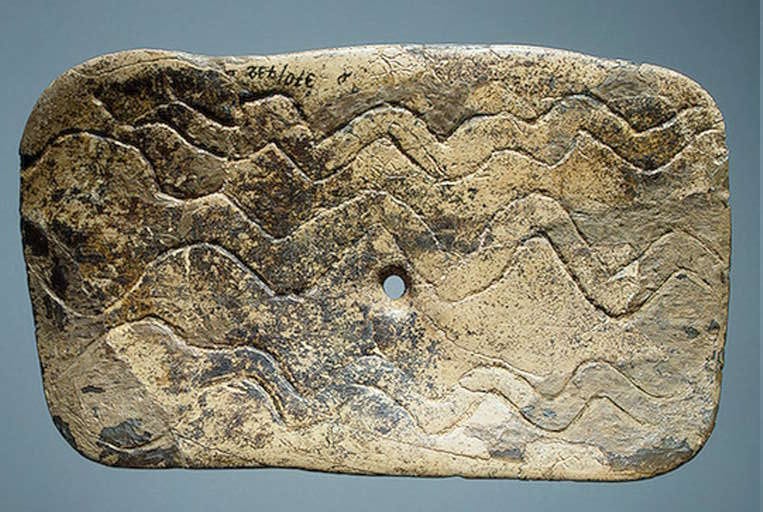September Subscriber Post
The labyrinth, the squatter, and the ancient enemies
Previously on Vectors of Mind
If I follow this trajectory, by next year my titles will be full paragraphs. For those who missed the chatbot piece, I’ve been hanging out on the SenpAI Discord server to discuss the latest in LLM therapists. Including, of course, OpenAI’s impressive new voice mode.
Links
Friend of blog Stetson started a podcast with a fascinating first episode on parenting. Listen, subscribe, check it out. Some may remember that Stetson helped me record the first VoM podcast.
The primordial labyrinth
Neurophysiologist argues that rock art was due to repeating patterns in the visual system common with migraines, hallucinations, and near-death experiences:
The hole in the center is interesting, as it could have been used to rotate the spiral. Readers of the blog are familiar with this artifact for the other side:
This is the earliest Snake Cult artifact I’ve identified, associated with the Mal’ta Buret culture 24,000 years ago in Siberia. At the same site, there were dozens of Venus figurines. Jungians identify the spiral or labyrinth with the path of individuation. But I want to point out the spiral is often connected with another symbol we’ve explored on VoM, the squatter. Here’s an example from Valcamonica, Italy, 8,000 years ago1:
And here in Columbia (undated).
I keep stumbling on more examples, including in the academic literature. Most recently, two subject area experts of rock art (Great Lakes region and the American Southwest) pondered the similar use of the symbol worldwide. They are sympathetic to multi-continental diffusion. I make that case in these articles:
On the meaning side of things, in the Eve Theory piece, I used a New Age graphic featuring the labyrinth to sum up EToC:

Part of the fun of EToC is that many different religions, including New Agers, are “right.” It’s a “yes, and” that makes improv (and conversation) flow.
Ancient enemies

Many Puebluan tribes such as the Hopi, Zuni, and Tiwa have versions of the snake dance, pictured above, and discussed in EToC v3. The bullroarer is part of the ritual, and is the hero image I used for the bullroarer piece:
Such practices among the Puebluans seem to be ancient, as there are dozens of shamans drawn holding snakes throughout the Southwest going back thousands of years. In Moab, Utah there is even a figure with a snake in his mouth:
As a child when I learned about the ancestors of the Pueblans in the Utah core curriculum they were called the Anasazi. Since then, this term has been replaced with “Ancestral Pueblan” because Anasazi is Navajo name meaning “ancient enemy.” This sentiment has not entirely subsided. Consider the YouTube channel Navajo Teachings, which usually features life wisdom and educational content. Typical is this video explaining Navajo belief about the Holy People who established their most important rituals:
However, when it comes to the Anasazi:
According to the Navajo Teacher, the Anasazi put themselves above the Holy People, even saying they were the Holy People. Eventually, that led to their downfall. There is so much oral history recorded in old books by anthropologists, and now with channels such as Navajo Traditional Teachings. Part of the promise of AI is that it can digest orders of magnitude more of it than any human, getting fragments of stories from many angles. In the future, this will be a valuable source for understanding the past.
Odds and ends
Long and popular. If you never got around to it, worth a read:
Similarly, if you like the genre of self-help cults gone wrong:
Forgive the clickbait title:
A must-read: Sam Altman on The Intelligence Age
“It is possible that we will have superintelligence in a few thousand days (!)”
“I believe the future is going to be so bright that no one can do it justice by trying to write about it now; a defining characteristic of the Intelligence Age will be massive prosperity.”
System prompt for OpenAI’s newest voice mode leaked by anon.
The most counterintuitive facts in all of mathematics, computer science, and physics
Two twitter threads critiquing the Reich lab paper that found evidence of selection for intelligence in the last 10,000 years:
This meta-analysis finds support for the Social Intelligence Hypothesis. This is particularly interesting from an Eve Theory perspective because if sociality was the key to human success, it follows that women would have been at the vanguard of human evolution for things like language and theory of mind.
Linguist Johanna Nichols has a recent paper on what pronoun distributions can tell us about the founding population of the Americas. Two decades ago, she wrote an even more ambitious paper about shared grammar around the Pacific Rim. It compared languages from the Americas to Asia to Australia: The Spread of Language Around the Pacific Rim, available on sci-hub
A worldwide phylogeny of knots is another way to gather evidence for cultural diffusion.
The classic Three Laws of Behavior Genetics and What They Mean by Erik Turkheimer was written almost 20 years ago. Worth returning to as the implication is that if behavior correlates with survival, then this implies there must be recent shifts in human propensities and perhaps abilities.
As always, there is a big asterisk on all rock art dates, particularly because this particular image is used by literally dozens of blogs (often with the 8,000 date), but I couldn’t find an associated paper or even a Wikipedia source. This meets my standard for a “links” post, but not for an article.





















